Table of Contents
Overview – Neurotransmitters
Neurotransmitters are chemical messengers essential for communication between neurons in the brain and peripheral nervous system. Understanding their synthesis, release, receptor types, and mechanisms of signal termination is vital for grasping neurological function, pharmacology, and the pathophysiology of many neurological and psychiatric conditions. This page breaks down key neurotransmitters and their clinical relevance for final-year medical students.
Definition
Neurotransmitters are endogenous chemicals that transmit signals from a neuron to a target cell across a synapse.
To qualify as a neurotransmitter, a substance must:
- Be synthesized in the neuron
- Be stored in vesicles
- Be released upon neuronal stimulation
- Act on a post-synaptic receptor
- Have a mechanism for termination of action
Synthesis & Packaging
Amine & Amino-Acid Neurotransmitters
- Synthesized in the axon terminal
- Packaging via H⁺-dependent transport into vesicles
Peptide Neurotransmitters
- Synthesized in the cell body (require nucleus & RER)
- Transported to terminal via Golgi apparatus
- All NTs have a rate-limiting step in synthesis (e.g., enzyme availability)
Controlled Release
- Triggered by Ca²⁺ influx, which activates vesicle mobilization proteins
- Exocytosis: Vesicle membrane fuses with pre-synaptic membrane → NT released
- Some NT may diffuse to neighboring synapses
- Botox disrupts release proteins → expressionless face
Receptor Activation
Ionotropic Receptors
- Ligand-gated ion channels
- Fast response
Metabotropic Receptors
- G-protein coupled
- Slower but longer-lasting effects via secondary messengers
Signal Termination
- Autoreceptors on pre-synaptic neuron provide negative feedback → ↓cAMP → ↓Ca²⁺ → ↓release
- Termination methods:
- Enzymatic degradation (e.g., ACh by acetylcholinesterase)
- Reuptake by pre-synaptic neuron
- Recycled into vesicles or
- Degraded (e.g., by MAO)
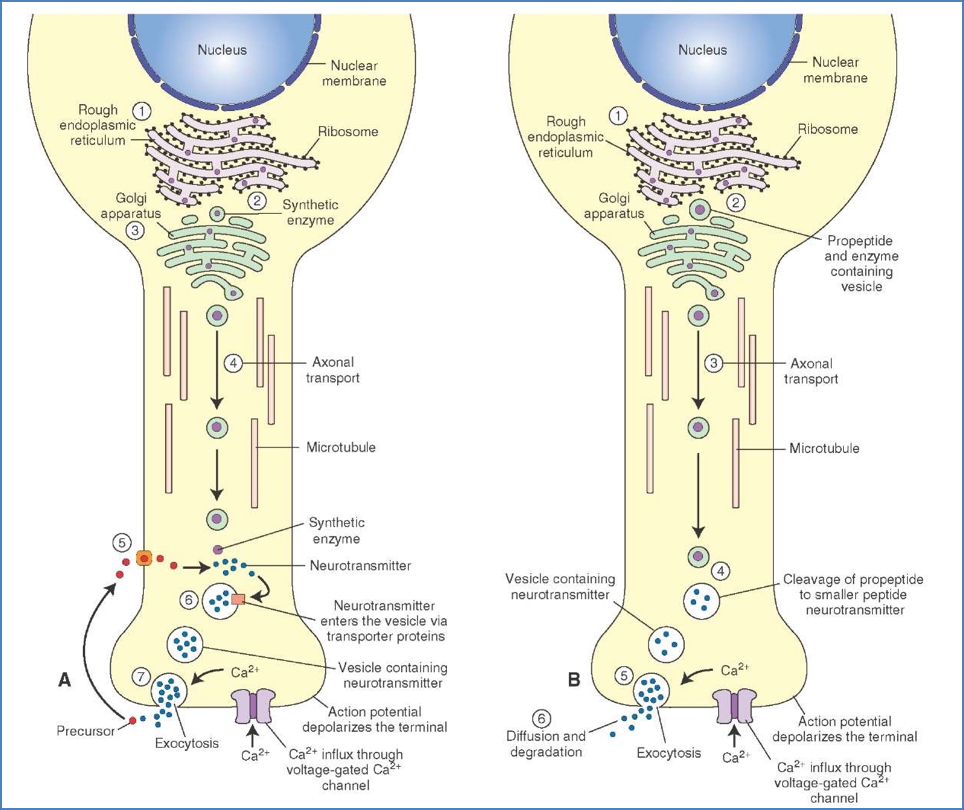
Regulation of Receptor Response
- Desensitization: ↓response due to ↓sensitivity
- Downregulation: ↓response due to ↓number of receptors
- Supersensitization: ↑response due to ↑sensitivity
- Upregulation: ↑response due to ↑number of receptors
Neuromodulation
- NTs not immediately reabsorbed → diffuse through CSF → global modulation
- Act as “volume control” for synaptic activity
- Released into synaptic cleft or extracellular fluid
Types of Neuromodulators:
- Metabolites: Adenosine, ATP, H⁺
- Hormones: Oestrogen
- Gases: NO, CO₂
- Amines: Dopamine, Serotonin, Histamine, ACh
- Proteins, Prostaglandins, etc.
Major Neurotransmitters
Amines (“Classical NTs”)
- Acetylcholine (ACh)
- Dopamine
- Noradrenaline (NE/NA)
- Serotonin (5-HT)
Amino Acids
- Glutamate: #1 excitatory NT
- GABA: #1 inhibitory NT
- Glycine
Peptides
- Cholecystokinin
- Enkephalins (e.g., Endorphins)
- Neuropeptide Y
- Somatostatin
- TRH
- VIP
Neurotransmitter Profiles
Acetylcholine (ACh)
Roles:
- Brain: Voluntary motor control, memory, sleep/wake, arousal
- Peripheral: Skeletal muscle contraction, parasympathetic functions
Synthesis:
- Choline + Acetyl-CoA → ACh (via choline-acetyltransferase)
Receptors:
- Muscarinic (metabotropic – parasympathetic)
- Nicotinic (ionotropic – NMJ, CNS, PNS)
Termination:
- Broken down by acetylcholinesterase → choline actively reabsorbed
Rate-Limiting Step:
- Reuptake of choline

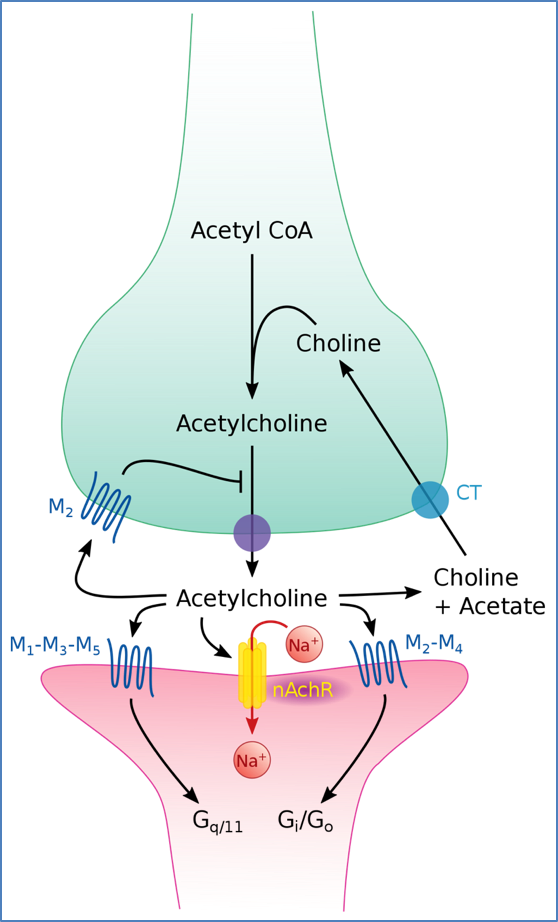
Dopamine
Roles:
- Brain: Motor control, cognition, reward, emotion, vomiting
- Peripheral: ↑Cardiac output, renal vasodilation
Synthesis:
- Tyrosine → Dopa (tyrosine hydroxylase) → Dopamine
Receptors:
- All metabotropic
Termination:
- Na⁺-dependent reuptake → repackaged or degraded by MAO
Rate-Limiting Step:
- Tyrosine hydroxylase activity


Noradrenaline (NA/NE)
Roles:
- Brain: Arousal, anxiety, pain, mood
- Peripheral: Fight/flight – ↑HR, BP, glucose, coronary perfusion
Synthesis:
- Tyrosine → Dopa → Dopamine → NA (in vesicles)
Receptors:
- Adrenergic (metabotropic)
Termination:
- Reuptake → repackaged or degraded by MAO
Rate-Limiting Step:
- Tyrosine hydroxylase
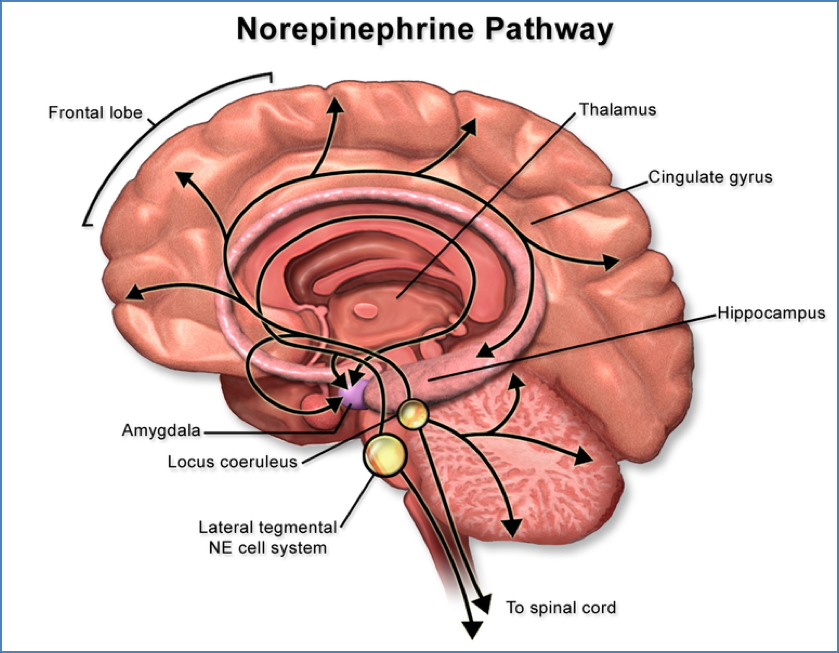
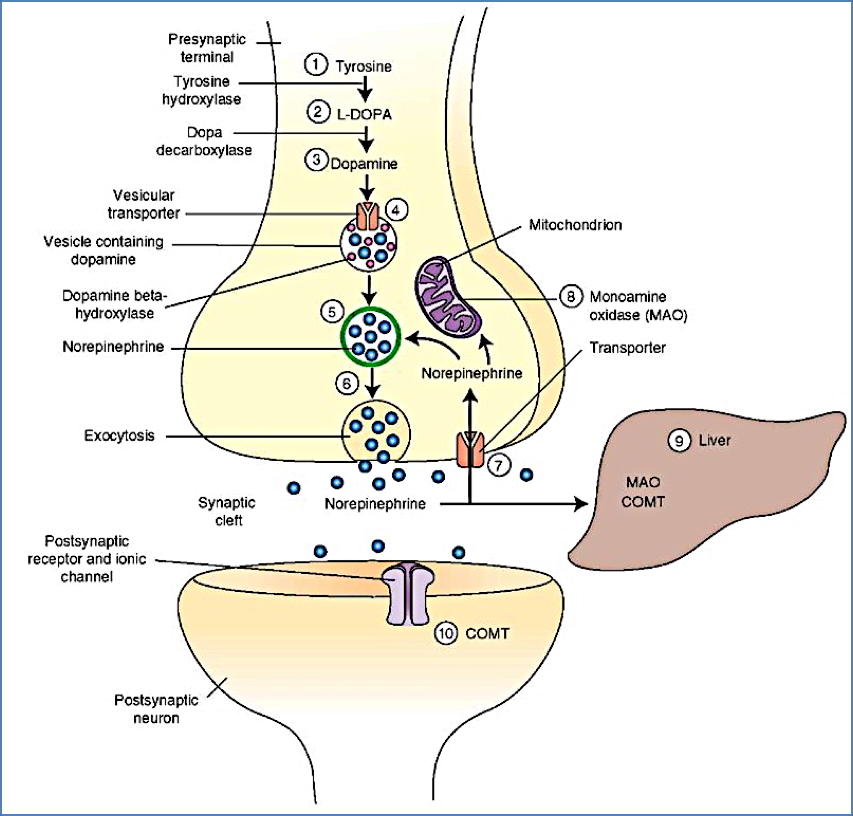
Serotonin (5-HT)
Roles:
- Brain: Mood, sleep-wake, circadian rhythm, pain
- Peripheral: GI tract motility, platelet function
Synthesis:
- Tryptophan → 5-HTP → 5-HT
Receptors:
- Ionotropic & metabotropic (5-HT receptors)
Termination:
- Na⁺-dependent reuptake → repackaged or degraded by MAO
Rate-Limiting Step:
- Tryptophan availability (diet-dependent)

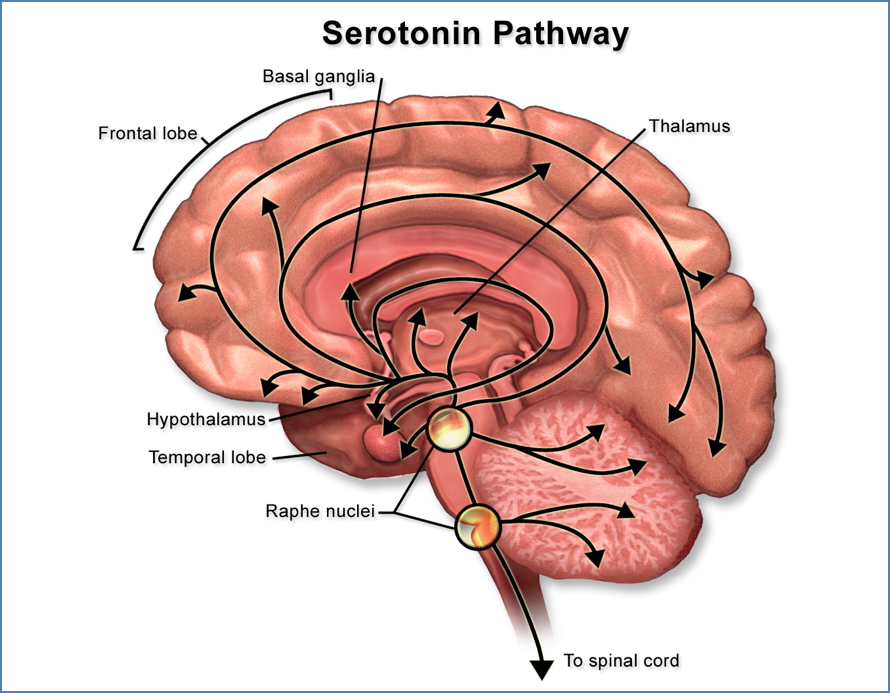
Glutamate
Role:
- Main excitatory NT in CNS
Synthesis:
- Glucose → α-Ketoglutarate → Glutamate
Receptors:
- Ionotropic: NMDA, AMPA, Kainate
- Metabotropic: mGluR
Termination:
- K⁺-dependent reuptake
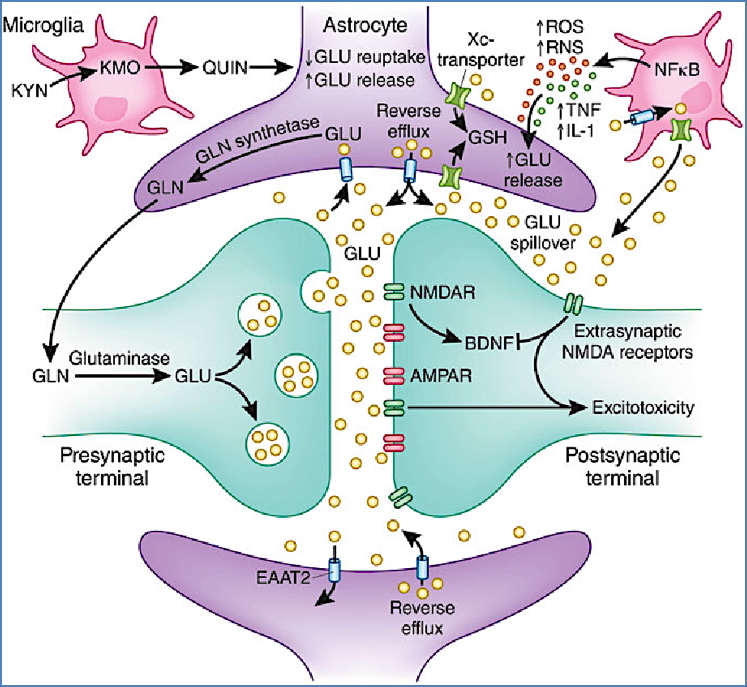
GABA
Role:
- Main inhibitory NT in CNS
Synthesis:
- Glucose → Glutamate → GABA (via glutamic acid decarboxylase + B6)
Receptors:
- GABA-A: Cl⁻ influx (ionotropic)
- GABA-B: K⁺ efflux (metabotropic)
Termination:
- Reuptake + degradation by GABA transaminase
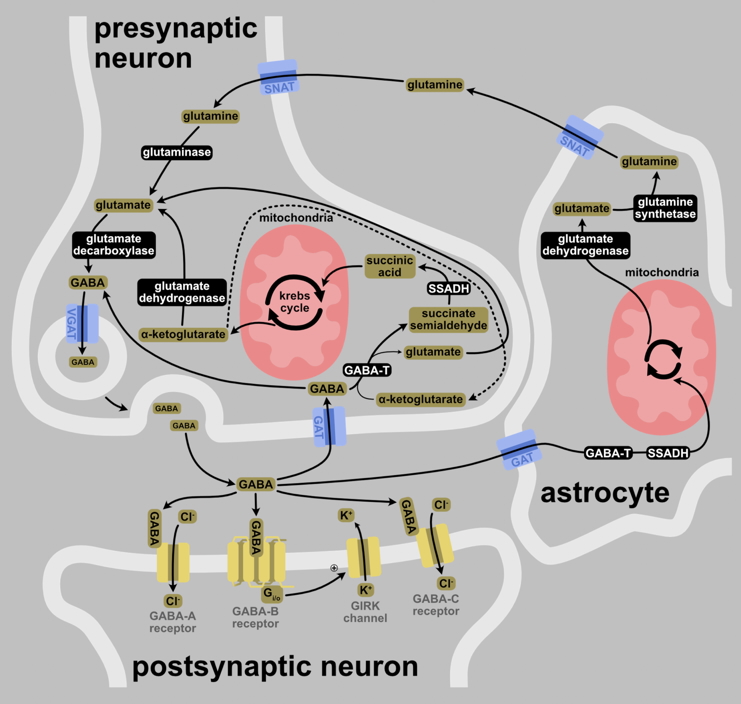
Glycine
Role:
- Inhibitory in brainstem/spinal cord
- Motor and sensory functions
Synthesis:
- Glucose → 3PG → Serine → Glycine
Receptors:
- Ionotropic Cl⁻ channels
Termination:
- Reuptake into pre-synaptic neuron
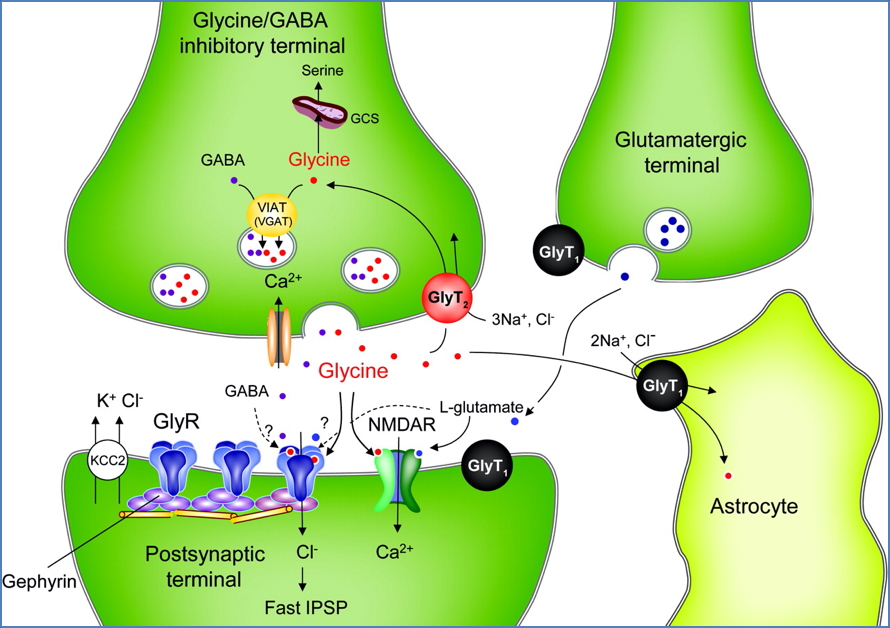
Summary – Neurotransmitters
Neurotransmitters are central to neural communication and function, with tightly regulated systems for synthesis, release, receptor interaction, and termination. Understanding their pathways helps explain key pharmacological targets and pathophysiological processes in both neurology and psychiatry. For a broader context, see our Nervous System Overview page.